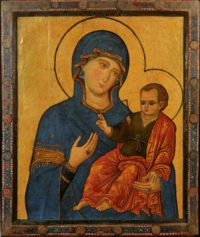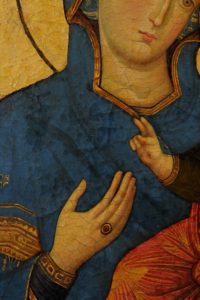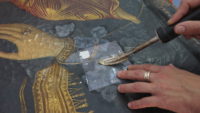 A famous medieval icon of the Madonna and Child traditionally held to have been painted by Saint Luke the Evangelist has been conclusively identified as the work of late 13th century artist Filippo Rusuti, creator of the grand upper facade of St. Mary Major. That mosaic depicting Christ enthroned among angels, saints and the symbols of the Evangelists actually bears the artist’s signature in mosaic tiles. The facade is today mostly hidden by the 18th century loggia built over it, but the verisimilitude of the signature made it possible for experts to confirm the one on the icon.
A famous medieval icon of the Madonna and Child traditionally held to have been painted by Saint Luke the Evangelist has been conclusively identified as the work of late 13th century artist Filippo Rusuti, creator of the grand upper facade of St. Mary Major. That mosaic depicting Christ enthroned among angels, saints and the symbols of the Evangelists actually bears the artist’s signature in mosaic tiles. The facade is today mostly hidden by the 18th century loggia built over it, but the verisimilitude of the signature made it possible for experts to confirm the one on the icon.
Art historians had previously attributed it to the Master of San Saba due to some stylistic similarities to frescoes in the nave of the Church of San Saba. A restoration that began in 2017 used the latest technology to analyze the panel painting (canvas mounted on walnut). That’s how the previously invisible signature of the artist was discovered. Like the mosaic, the icon is Byzantine in style with rigid figures imbued with symbolism rather than naturalistic postures and affect.
The icon’s permanent home is the church of Santa Maria del Popolo to which it has deep ties extending back to the 13th century. The church’s founding and early history is hazy — many church records were destroyed during the Napoleonic occupation of Rome — but it does appear on a list of Roman churches from the late 1220s, early 1230s. The physical structure as it exists today is largely Baroque, an expansion and reconstruction designed by Gianlorenzo Bernini in the mid-17th century that drastically altered its 15th century predecessor. The greatest international claim to fame and tourist attraction of Santa Maria del Popolo today, the Cerasi Chapel with its two Caravaggio masterpieces, Crucifixion of St. Peter and Conversion on the Way to Damascus, dates to the Baroque reconstruction.
 Long before the Caravaggio pilgrims lined up on the church steps waiting for it to open, however, pilgrims seeking the blessings of the Madonna traveled to Santa Maria del Popolo to venerate the icon. Legend dates its miraculous reputation back to the earliest records of the church. The story goes that the icon of Virgin and Child was painted by the very hand of St. Luke the Evangelist and kept with the rest of the most important relics in Christendom in the Sancta Sanctorum of the Lateran palace, the Pope’s residence. In 1230, the Tiber overflowed its banks, as it was wont to do, and with the flood came plague. To cure the city of this pestilence, the Pope led the city in a procession carrying aloft the icon to Santa Maria del Popolo. The plague ended and the Madonna of San Luca became one the most venerated icons in Rome.
Long before the Caravaggio pilgrims lined up on the church steps waiting for it to open, however, pilgrims seeking the blessings of the Madonna traveled to Santa Maria del Popolo to venerate the icon. Legend dates its miraculous reputation back to the earliest records of the church. The story goes that the icon of Virgin and Child was painted by the very hand of St. Luke the Evangelist and kept with the rest of the most important relics in Christendom in the Sancta Sanctorum of the Lateran palace, the Pope’s residence. In 1230, the Tiber overflowed its banks, as it was wont to do, and with the flood came plague. To cure the city of this pestilence, the Pope led the city in a procession carrying aloft the icon to Santa Maria del Popolo. The plague ended and the Madonna of San Luca became one the most venerated icons in Rome.
Several Popes and cardinals were passionately devoted to the icon. The high altar of Santa Maria del Popolo was commissioned, likely by Cardinal Rodrigo Borgia, in 1473 to showcase it. One of those popes, Sixtus V, put Santa Maria del Popolo on the list of the Seven Pilgrim Churches of Rome in 1586, replacing the church of Saint Sebastian on the Appia outside the walls, solely because of the importance of icon.
 I came so close to seeing the restored icon last week, darn it. It is currently on display at the Castel Sant’Angelo through November 18th. I didn’t even realize it was there and I probably wouldn’t have thought anything of it even if I had known because I’ve seen the icon at Santa Maria, albeit not within such close view. I did have the Castel Sant’Angelo’s exhibition of arms and armature on the short list, however, and saw the other half of that show at the Palazzo Venezia. Time got away with me is all, what with all the questing and wall walking.
I came so close to seeing the restored icon last week, darn it. It is currently on display at the Castel Sant’Angelo through November 18th. I didn’t even realize it was there and I probably wouldn’t have thought anything of it even if I had known because I’ve seen the icon at Santa Maria, albeit not within such close view. I did have the Castel Sant’Angelo’s exhibition of arms and armature on the short list, however, and saw the other half of that show at the Palazzo Venezia. Time got away with me is all, what with all the questing and wall walking.